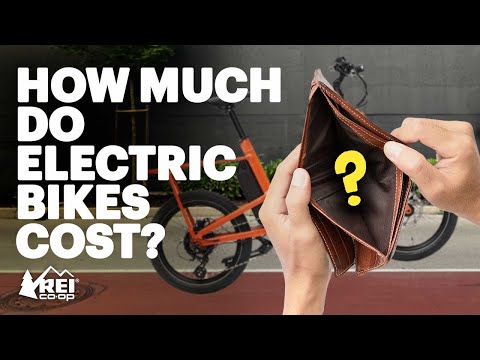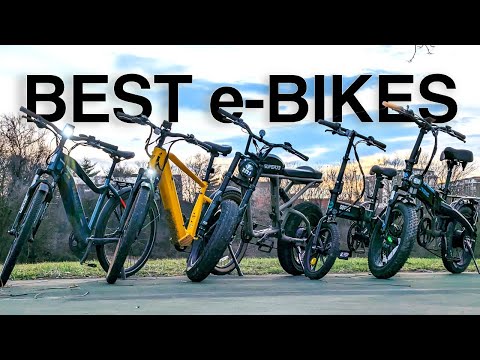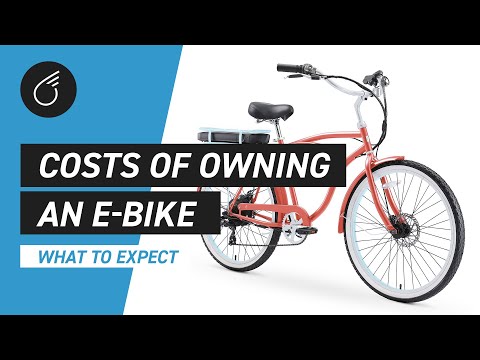Electric bikes are becoming a popular choice for those looking to combine the joy of cycling with a little extra power. With more people turning to e-bikes for commuting and leisure, it’s natural to ask: how much will an electric bike set you back?
Electric bikes can range from as low as $500 for a basic no-name model to over $15,000 for high-end options. The average price people spend on their first electric bike is around $2,000, but mid-range models usually cost between $1,700 and $2,600. The price varies greatly depending on the type, quality, and features of the bike.
This article will explore the factors affecting e-bike prices, such as type and riding experience. Whether you’re planning to use an electric bike for daily commuting or weekend adventures, understanding the costs involved can guide you to make a smart purchasing decision.
What Factors Influence Electric Bike Cost?
The cost of an electric bike is shaped by several factors. These include the materials used in its construction, the specifications of the motor and battery, and any extra features or accessories it might have. Each element adds value and influences pricing in different ways.
Design and Materials
Design and materials are crucial when considering an electric bike’s cost. Frames can be made of steel, aluminum, or carbon fiber. Each material affects both performance and price. Steel provides strength and durability but tends to be heavier. High-grade aluminum offers a balance of weight and performance, while carbon fiber makes for a lighter, high-performance bike, often at a higher cost.
The structure of the bike also plays a part. Simple, streamlined designs can be less expensive. In contrast, more intricate frames with unique styling can increase prices. Users seeking a lightweight bike, like the Ancheer Folding Electric Bike, might value these materials differently, tailoring choices to their budget and needs.
Motor and Battery Specs
An electric bike’s motor and battery determine how powerful and long-lasting the bike can be. Motor types include hub motors and mid-drive motors. Hub motors are often less costly and easier to maintain, placed in the wheel. Mid-drive motors provide better balance and torque but usually come at a premium.
Battery specs also significantly affect cost. Lithium-ion batteries, known for their efficiency and lighter weight, are generally more expensive but favored for their extended battery range and life. Lead-acid batteries are cheaper but heavier and offer less range. Bikes with integrated batteries present a sleek look but may drive up costs.
Extra Features and Accessories
Additional features can make an electric bike stand out and alter its price. Integrated lights and pedal assist systems enhance safety and riding ease. These features are valued by commuters and casual riders alike. Bikes with more advanced e-bike extras such as GPS tracking or mobile connectivity typically cost more.
Accessories like rear racks, fenders, or a comfortable saddle also add to the overall expense. Options like the Cyclamatic Power Plus CX1 might offer a range of these features, providing a balance of cost and functionality that caters to different lifestyles and preferences.
Types of Electric Bikes and Pricing Tiers
Electric bikes come in a variety of types and pricing tiers. This can range from budget-friendly options to high-end models. Each category serves different needs like commuting or mountain biking. Below, we will explore different types of electric bikes and their respective pricing levels.
Entry-Level and Budget-Friendly E-Bikes
Entry-level e-bikes are ideal for first-time owners or those on a budget. These models are often among the cheapest e-bikes available. Prices for these bikes are generally around or under $1,000. An example is the Ancheer Folding Electric Bike, which is popular for its affordability and utility.
These bikes usually include basic features like pedal assist and modest top speeds. They are perfect for city commutes and short trips. While they don’t have the advanced specs of high-end bikes, they offer great value for short distance needs.
Many models in this category aim to balance performance and cost. Some entry-level e-bikes are also folding electric bikes, making them convenient for storage or public transport.
Specialized E-Bikes for Every Need
Specialized e-bikes cater to specific purposes like mountain biking, road biking, and cargo transport. Electric mountain bikes and electric road bikes focus on different terrains and experiences. Mountain bikes are designed to handle rugged terrain with enhanced suspension.
Cargo electric bikes are useful for carrying heavy loads or even children. Prices for these bikes can vary widely depending on features but generally start a bit higher than entry-level models. Expect to see prices from $1,500 to $4,000.
Commuter e-bikes are designed for daily use in urban settings, offering comfort and efficiency. Meanwhile, folding e-bikes provide flexibility for those needing compact storage.
High-End Models for the Connoisseur
High-end e-bikes are crafted for enthusiasts who prioritize performance and durability. They usually come from premium brands with good reputations. These bikes can cost anywhere from $3,000 to well over $10,000.
These models often have high-tech integrations like advanced frame materials, superior motor power, and enhanced battery life. They are ideal for those who demand premium quality, whether for intense daily commutes or long-distance rides.
High-end models are often considered luxury items, offering an unmatched biking experience. They target connoisseurs who appreciate both the engineering and design in their e-bike investments.
The Long-Term Costs of Owning an E-Bike
Owning an electric bike involves more than just the initial purchase price. Riders need to consider ongoing costs such as maintenance, battery care, and insurance. Understanding these long-term expenses will help in budgeting effectively.
Maintenance and Repairs
Regular maintenance keeps an e-bike running smoothly. Expect to pay for tune-ups, tire replacements, and brake checks. Maintenance costs vary, but generally, they might range from $50 to $100 annually. Repair costs can be higher if major components like the motor or electronics need fixing.
It’s wise to maintain a savings buffer for unexpected repairs. Routine checkups can prevent costly breakdowns. A simple checklist for maintenance includes:
- Checking tire pressure
- Cleaning and lubricating the chain
- Inspecting brakes for wear
Keeping up with these tasks helps minimize major repair costs down the road.
Battery Charging and Replacement
Charging costs depend on local electricity rates. Generally, e-bike charging is quite affordable. For example, charging a standard battery might cost a few cents per charge. However, the long-term expenses include replacing the battery every few years.
Battery replacement can be one of the higher long-term costs. Typically, a new battery ranges from $200 to $500. Proper care can extend battery life, reducing the frequency of replacements. Tips for prolonging battery life:
- Avoid extreme temperatures
- Regularly charge the battery, even during storage
- Follow the manufacturer’s guidelines for charging
Insurance and Safety
Insurance provides protection against theft or accidents. The cost of an insurance policy for an electric bike varies depending on the coverage. Some homeowners’ insurance policies might cover e-bikes, but it’s important to confirm specifics with the insurer or consider separate coverage.
Ensuring adequate safety gear, like helmets and lights, is also crucial. Although gear costs are a one-time expense, insurance might be an ongoing one. Key factors to consider for insurance:
- Coverage options
- Possible discounts for safety features
- Policy limits and deductibles
Investing in protection and safety equipment is essential for peace of mind during rides.
Economic and Environmental Benefits
Electric bikes are not only a convenient mode of transportation, but they also offer numerous economic and environmental advantages. Governments often support their use through various incentives, while the reduction in carbon emissions can make a notable impact on the environment.
Government Incentives and Programs
Governments are eager to reduce air pollution and traffic congestion, so they offer incentives for electric bike users. These incentives can include rebates, tax credits, and even special financing options. Some areas provide rebates of up to $1,000, making the initial investment more affordable.
For instance, both federal and local programs may offer specific incentives tailored to electric bike purchases. These benefits aim to encourage individuals to switch from traditional gas-powered vehicles to more eco-friendly options.
Make sure to check local government websites for current programs and eligibility. These incentives often make a significant difference in the overall cost of owning an electric bike.
Reducing Your Carbon Footprint
Electric bikes play a crucial role in decreasing carbon emissions. A study shows that e-bikes emit 40 to 140 times fewer greenhouse gases than cars. This reduction not only helps combat climate change but also improves air quality in urban areas.
E-bikes utilize electric components from brands like Bosch and Shimano, known for their efficiency and reliability. By combining these components with human power, they reduce dependency on fossil fuels.
Every mile traveled on an electric bike instead of a car counts towards lowering one’s carbon footprint. This makes electric bikes an excellent way for individuals to commit to personal environmental stewardship while enjoying the economic perks.
Before You Buy: Tips and Tricks
Purchasing an electric bike can be an exciting venture. Understanding e-bike classes, finding smart financing options, and taking a few test rides are key steps to ensure your purchase brings you joy and satisfaction. Each of these aspects plays a crucial role in making an informed decision.
Understanding E-Bike Classes and Restrictions
E-bikes come in different classes, mainly class one, class two, and class three. Class one e-bikes provide pedal assist without a throttle, while class two e-bikes have throttles and a maximum speed of 20 mph. Class three e-bikes offer pedal assist up to 28 mph without a throttle.
Knowing these distinctions is important. Different locations have specific laws on where each class can be ridden. For instance, class three e-bikes might be restricted in certain bike lanes. Awareness of these rules helps avoid run-ins with the law.
Understanding the class of your electric bike can also impact where you go and what sort of adventures you embark on. Each class has its own perks, and knowing them ensures your bike matches your lifestyle, whether it’s city cruising or tackling rugged paths.
Financing Options and Smart Shopping
Buying an electric bike can feel like a big investment. Prices can range from several hundred to several thousand dollars. For those who want an e-bike without breaking the bank, smart financing options can be a big help.
Some retailers offer financing plans that split the cost into manageable monthly payments. This can make even high-priced bikes seem more affordable. Exploring options like these gives potential buyers flexibility and peace of mind.
Online retail platforms sometimes have discounts or seasonal sales. Keeping an eye out for such offers can help save some cash. Comparing prices across different shop fronts ensures you’re getting the best deal available.
Test Ride: Finding the Perfect Fit
A test ride is an essential part of the buying process. Just like shoes, the fit of an electric bike can make or break your enjoyment. Not only does a test ride allow you to feel the comfort, but it also gives you a chance to understand how the bike handles and operates.
During a test ride, focus on the bike’s responsiveness, brake efficiency, and comfort. Try different models, if possible, to see which works best for your needs. It’s also a great opportunity to sense how the bike accelerates, particularly if you’re considering a class two e-bike.
Finding an electric bike that suits your riding style can transform an ordinary commute into a delightful journey. A good fit ensures you enjoy every pedal.
Frequently Asked Questions
Electric bikes, also known as e-bikes, have different price ranges based on their type and where you buy them. Here’s what you need to know about costs for different styles and sizes.
What’s the average sticker shock for an e-bike these days?
E-bikes can range from quite affordable to high-end. Basic models can start at around $500, while more advanced ones can climb up to $2,000 and beyond, based on features and designs. For a wide range, Aventon e-bikes, for example, are priced from $999 to $2,699.
Are adult-sized e-bikes gonna cost me an arm and a pedal?
Most adult-sized e-bikes are within the $1,000 to $3,000 range. Quality and brand play a big role in this. High-end models have better components, which can push prices higher.
Will I break the bank if I snag an electric bike from a big box retailer?
Big box retailers often have budget-friendly options. You might find a decent e-bike for as low as $500 there, though these might lack advanced features. Consider quality and long-term durability before deciding.
Just curious: How heavy is the price tag for pint-sized electric bikes?
Electric bikes for kids are usually less expensive. They can range from about $200 to $700, depending on the brand and features. These pint-sized options are generally lighter on both weight and price.
What’s the going rate for two-wheeled lightning (aka electric dirt bikes)?
Electric dirt bikes can vary widely depending on power and performance. Prices start around $2,000 for entry-level models, while high-performance versions may cost $5,000 or more. They’re perfect for throwing some fun into your off-road adventures.
How many pretty pennies for an e-bike that’ll last longer than my love for spin class?
A long-lasting e-bike, likely with quality battery life and durable components, might be found in the $1,500 to $4,000 range. Spending more upfront usually means fewer repairs or replacements down the road, making it a worthy investment for many.





